Charles E W Bean, Diaries, AWM38 3DRL 606/117/1 - September - December 1918 - Part 2
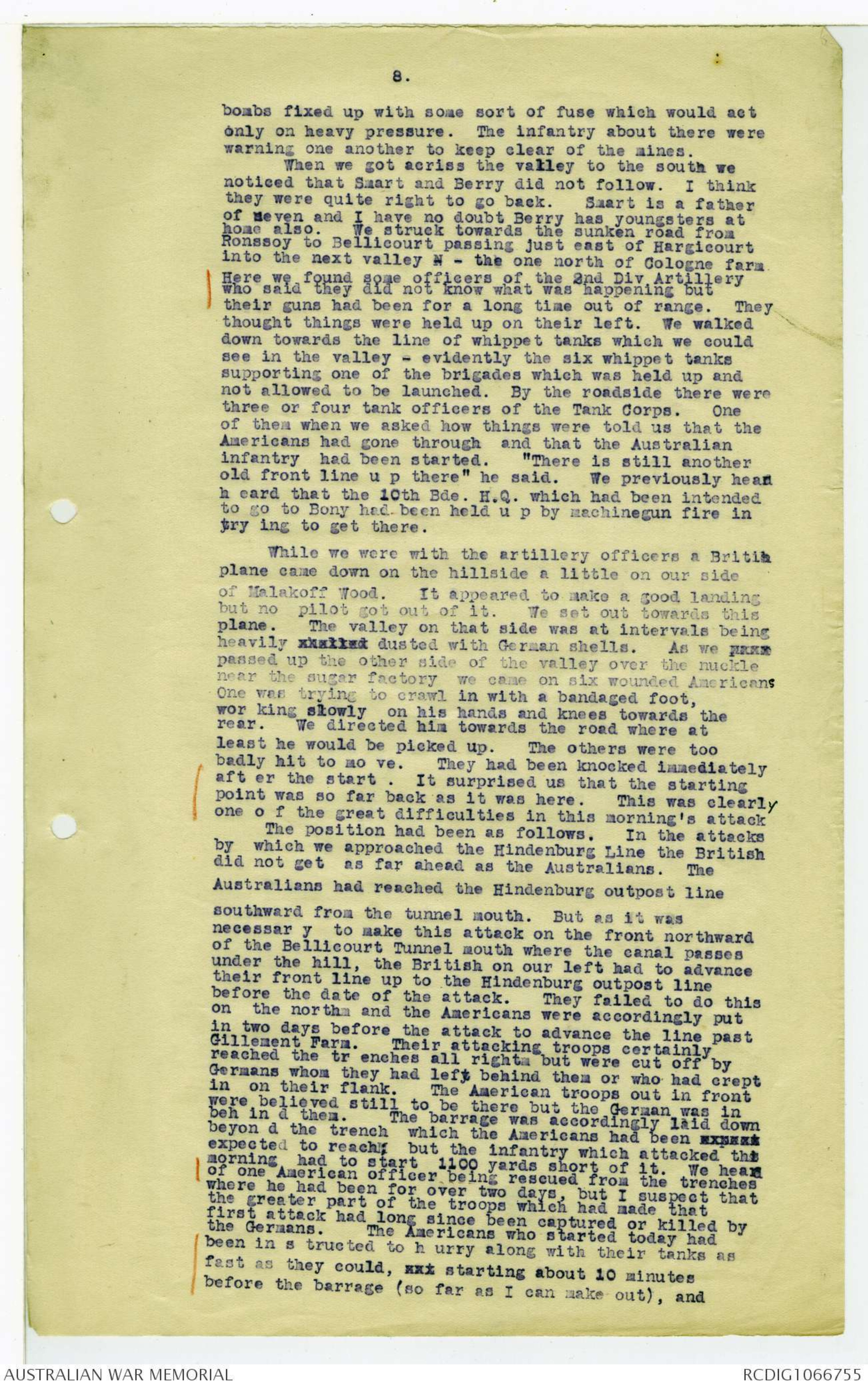
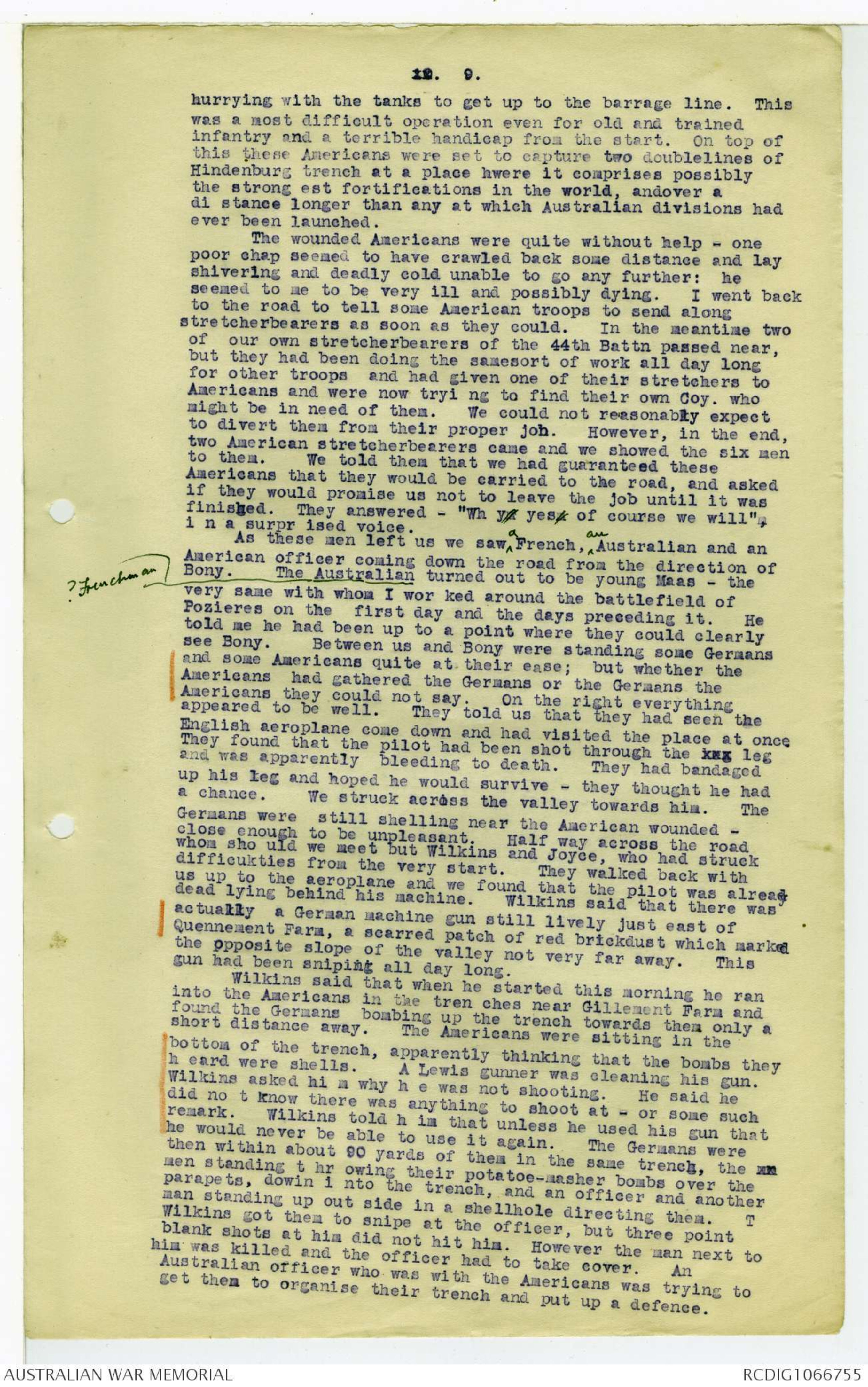
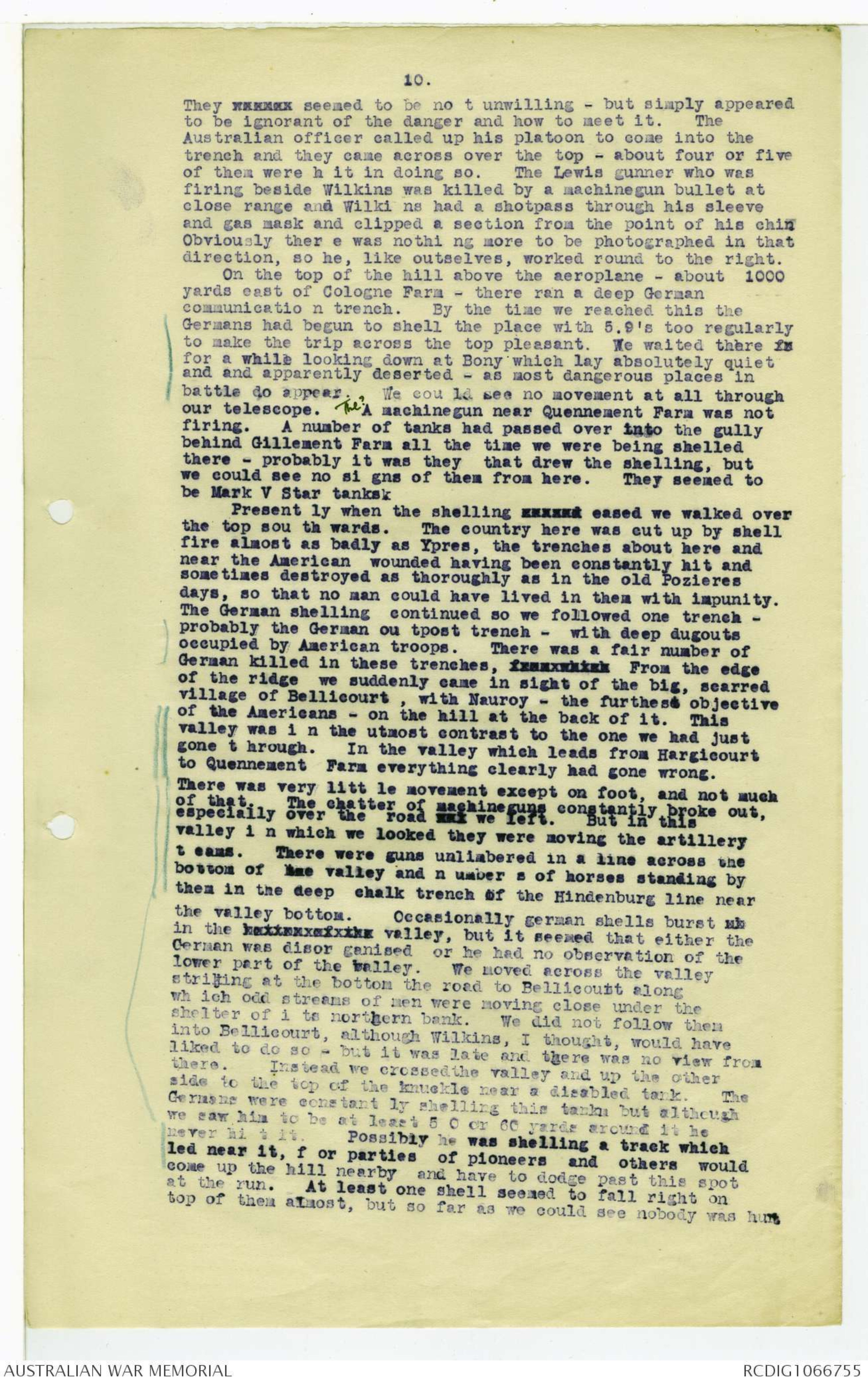
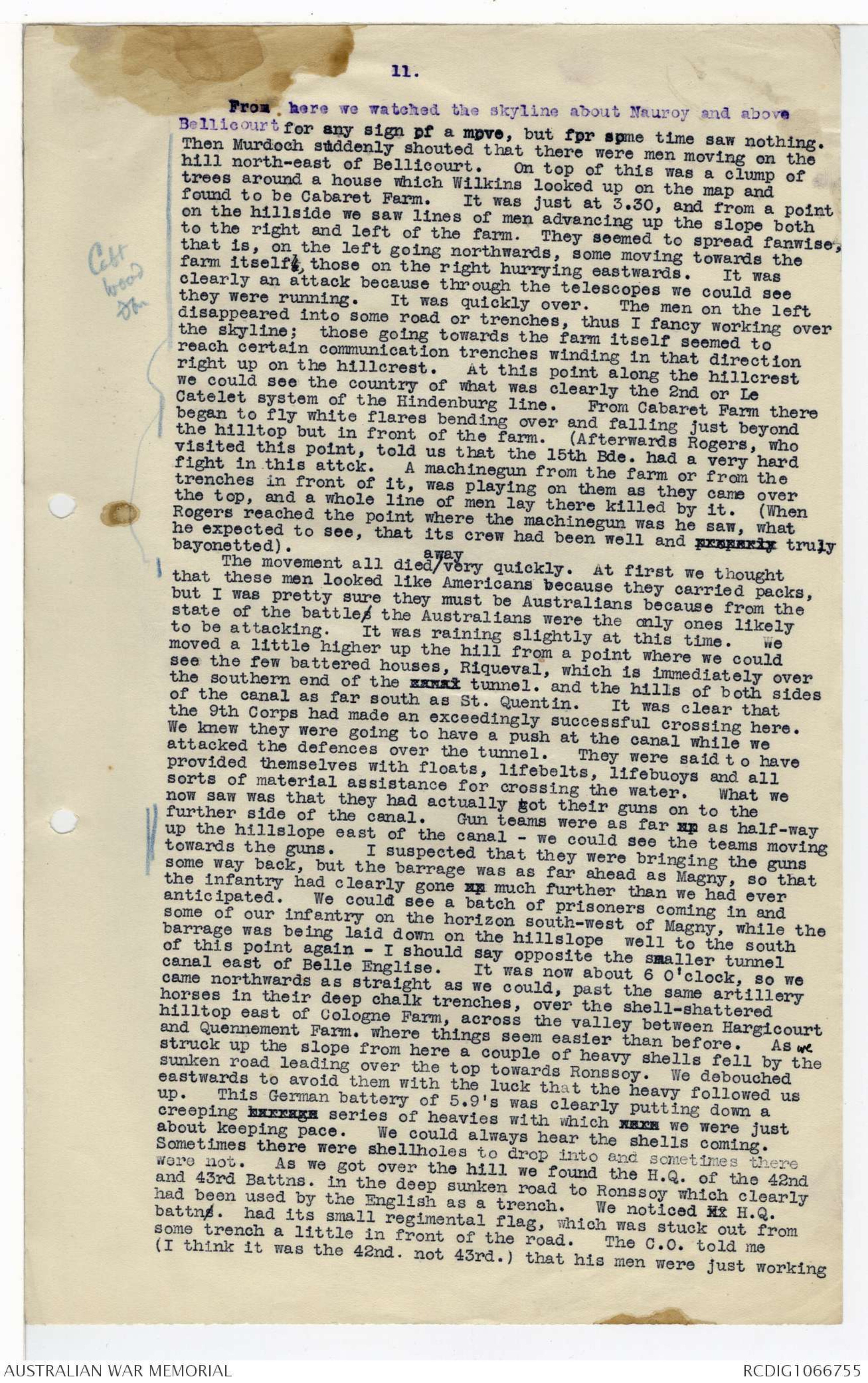
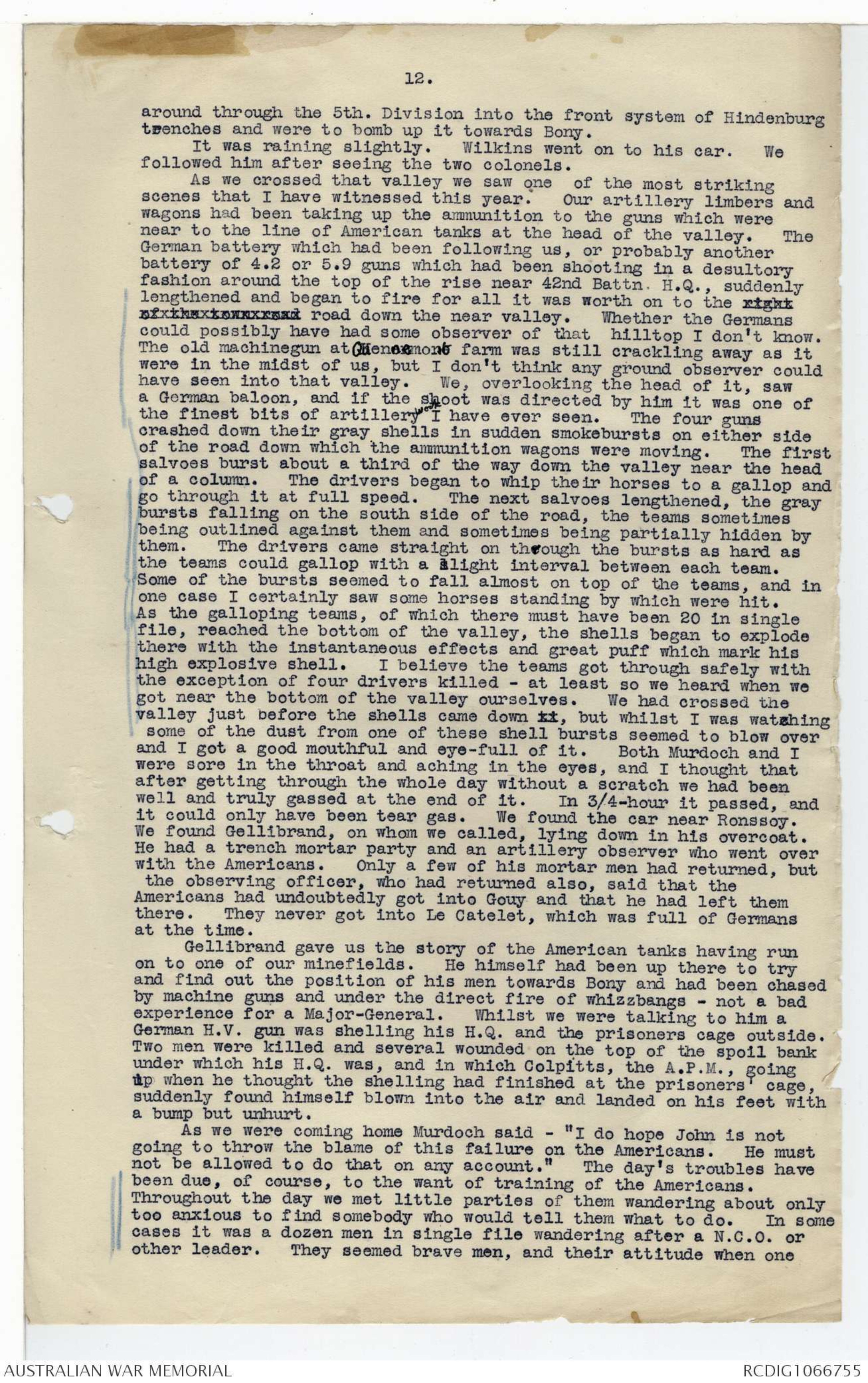
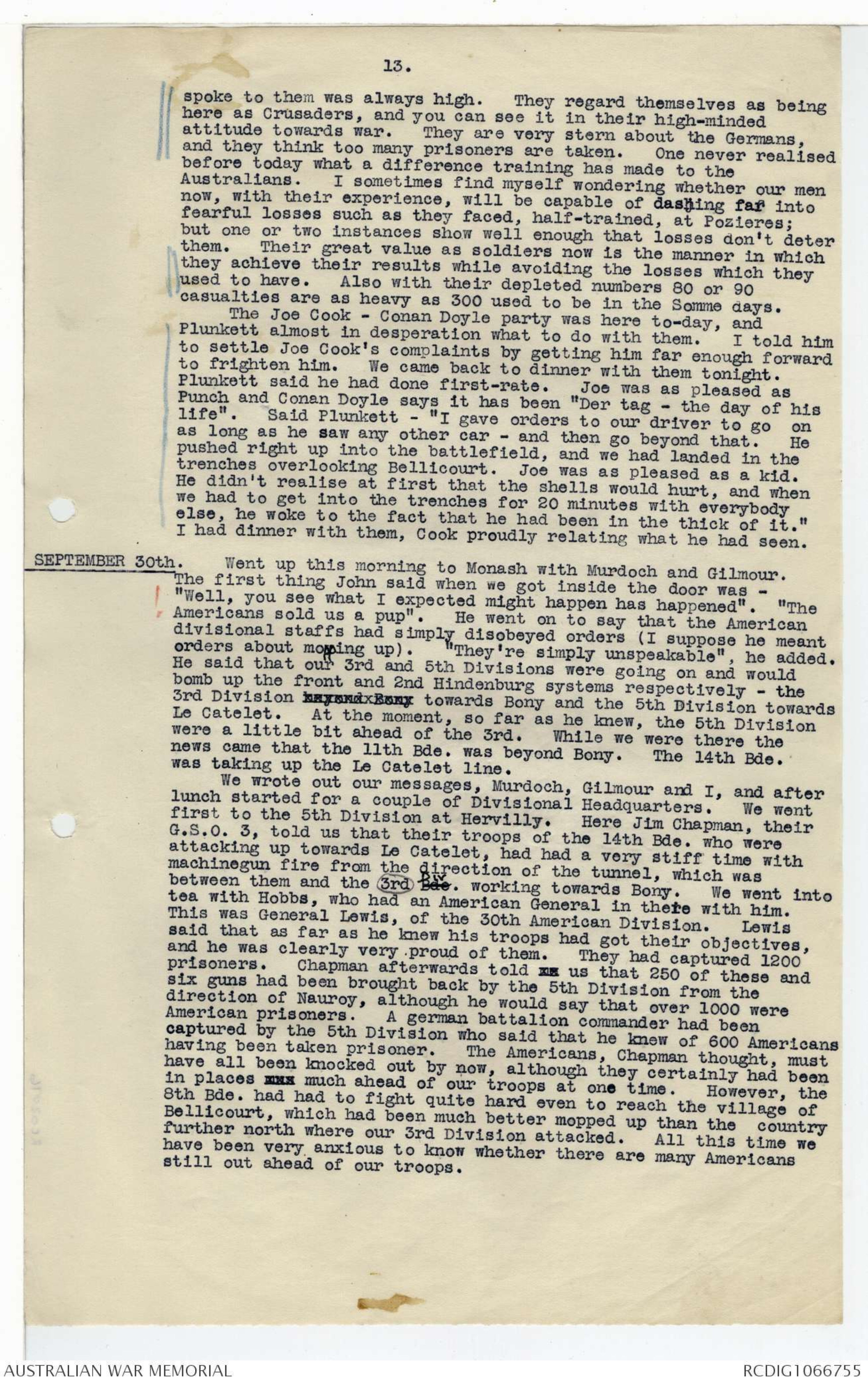
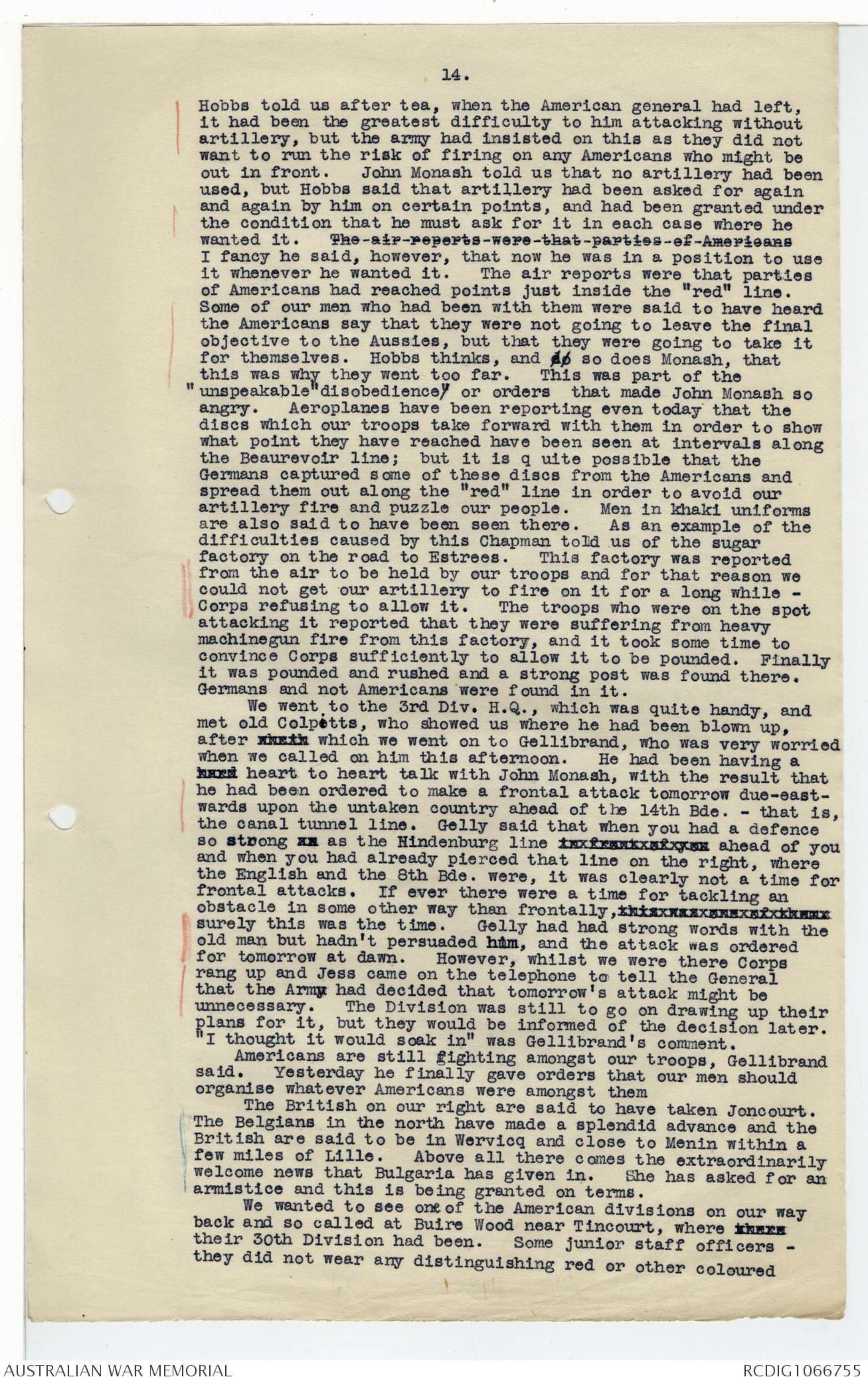
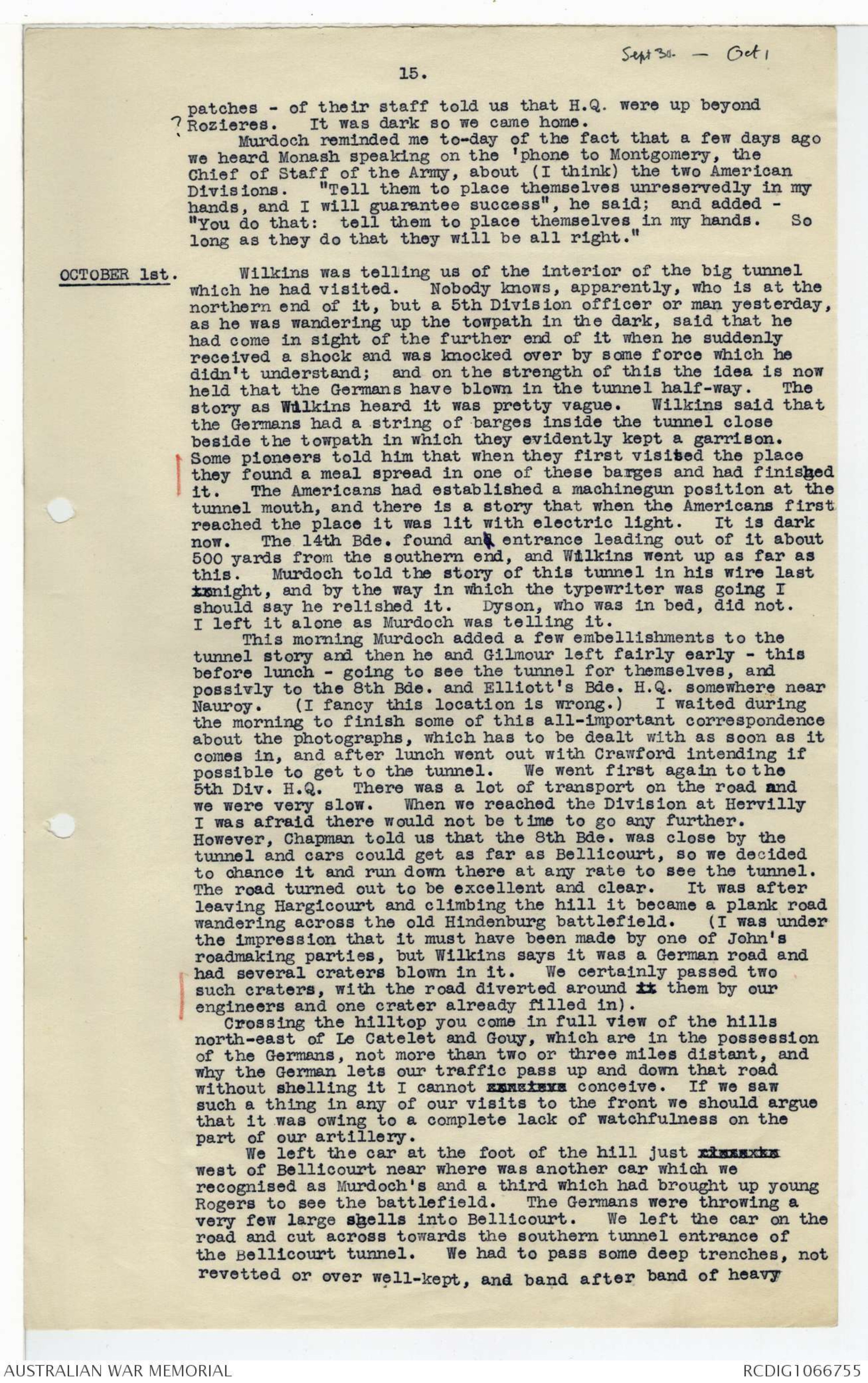
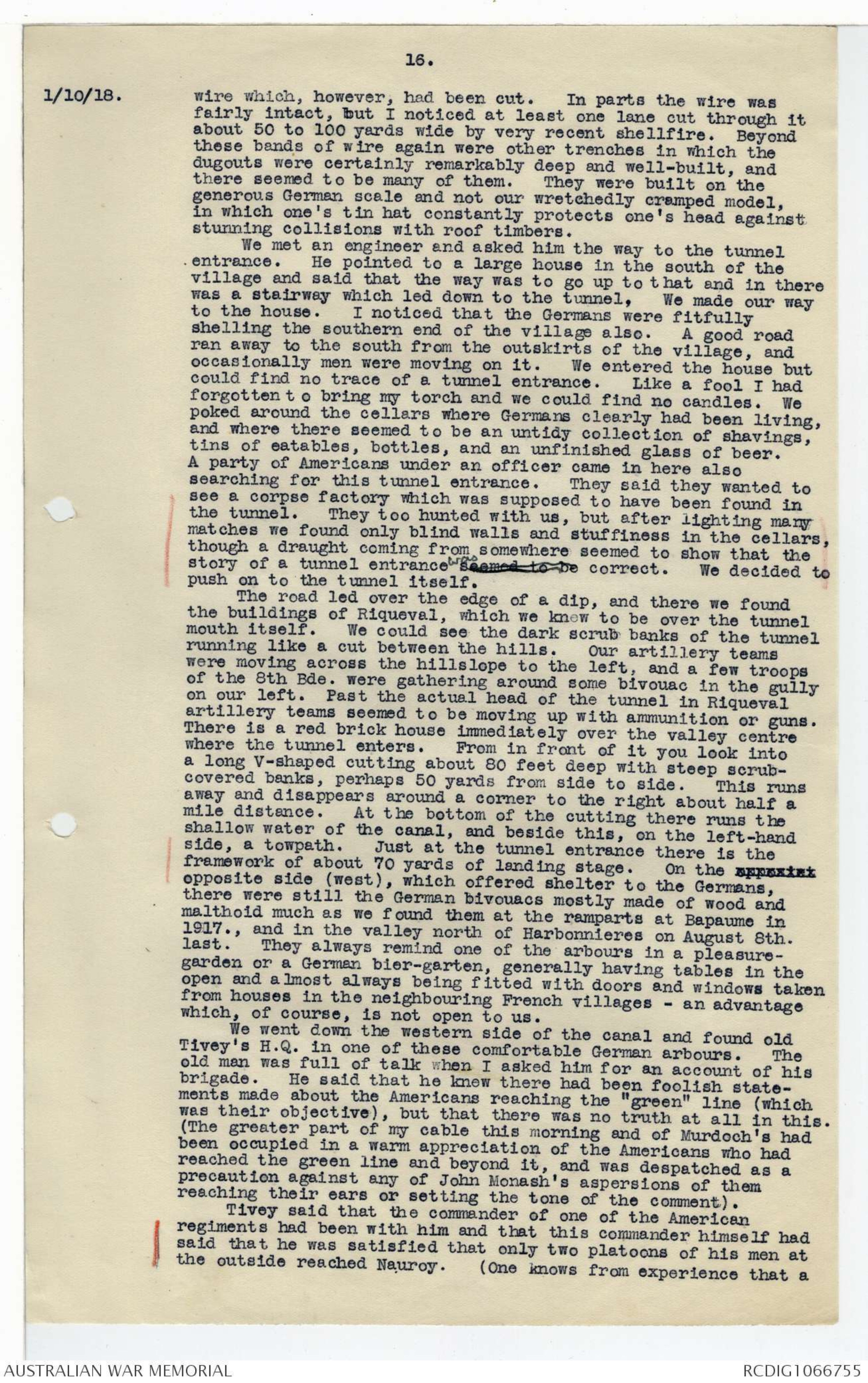
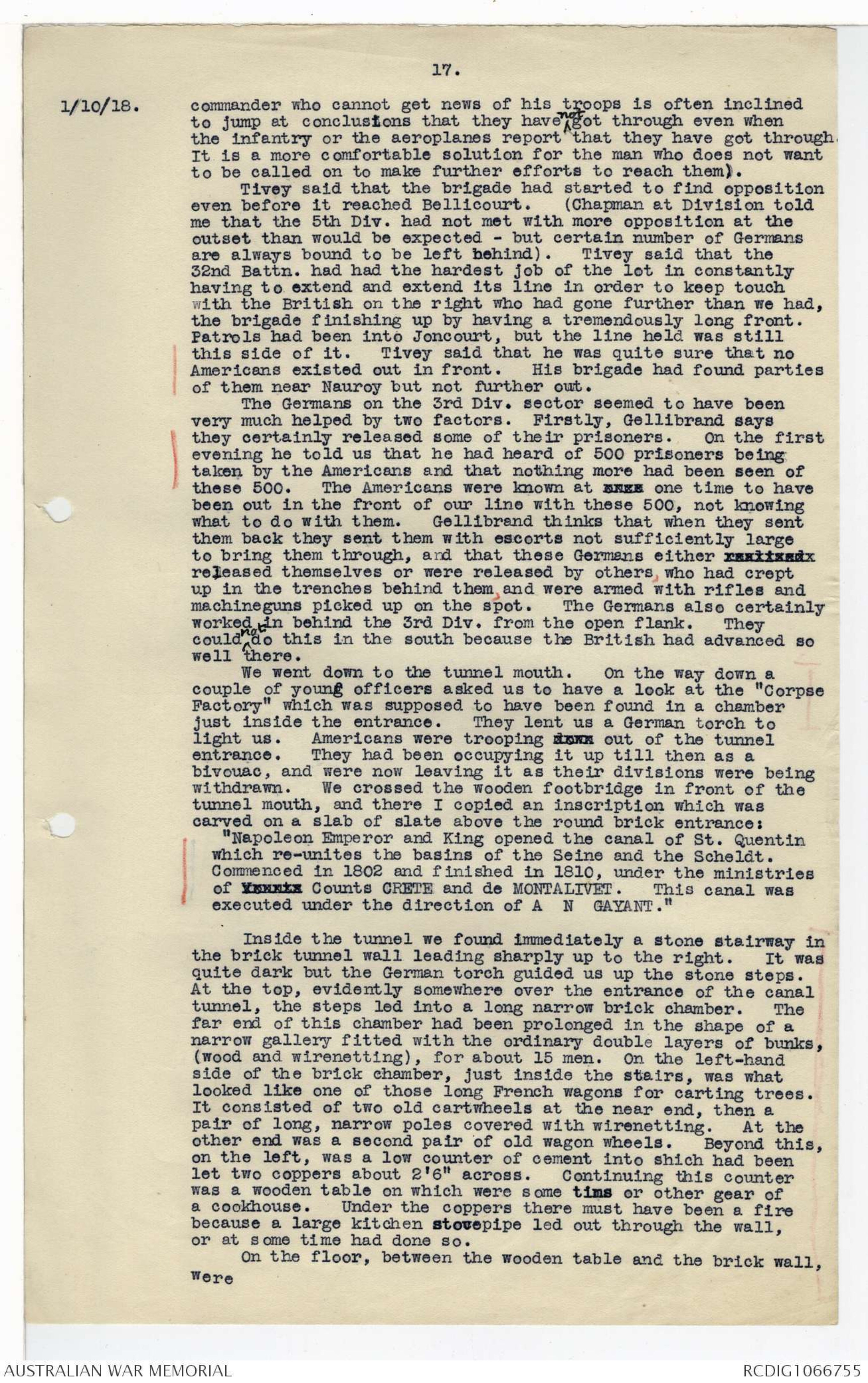
8.
bombs fixed up with some sort of fuse which would act
only on heavy pressure. The infantry about there were
warning one another to keep clear of the mines.
When we got acriss the valley to the south we
noticed that Smart and Berry did not follow. I think
they were quite right to go back. Smart is a father
of seven and I have no doubt Berry has youngsters at
home also. We struck towards the sunken road from
Ronssoy to Bellicourt passing just east of Hargicourt
into the next valley N - the one north of Cologne farm
Here we found some officers of the 2nd Div Artillery
who said they did not know what was happening out
their guns had been for a long time out of range. They
thought things were held up on their left. We walked
down towards the line of whippet tanks which we could
see in the valley - evidently the six whippet tanks
supporting one of the brigades which was held up and
not allowed to be launched. By the roadside there were
three or four tank officers of the Tank Corps. One
of them when we asked how things were told us that the
Americans had gone through and that the Australian
infantry had been started." There is still another
old front line up there" he said. We previously hean
h eard that the 10th Bde. H.Q. which had been intended
to go to Bony had been held u p by machinegun fire in
try ing to get there.
While we were with the artillery officers a British
plane came down on the hillside a little on our side
of Malakoff Wood. It appeared to make a good landing
but no pilot got out of it. We set out towards this
plane. The valley on that side was at intervals being
heavily dusted with German shells. As we naxx
passed up the other side of the valley over the nuckle
near the sugar factory, we came on six wounded Americans
One was trying to crawl in with a bandaged foot,
wor king slowly, on his hands and knees towards the
rear.
We directed him towards the road where at
least he would be picked up. The others were too
badly hit to mo ve. They had been knocked immediately
aft er the start. It surprised us that the starting
point was so far back as it was here. This was clearly
one o f the great difficulties in this morning's attack
The position had been as follows. In the attacks
by which we approached the Hindenburg Line the British
did not get as far ahead as the Australians. The
Australians had reached the Hindenburg outpost line
southward from the tunnel mouth. But as it was
necessar y, to make this attack on the front northward
of the Bellicourt Tunnel mouth where the canal passes
under the hill, the British on our left had to advance
their front line up to the Hindenburg outpost line
before the date of the attack. They failed to do this
on the northm and the Americans were accordingly put
in two days before the attack to advance the line past
Gillement Farm. Their attacking troops certainly
reached the tr enches all righta but were cut off by
Germans whom they had left behind them or who had crept
in on their flank. The American troops out in front
were believed still to be there but the German was in
beh in d them. The barrage was accordingly laid down
beyon d the trench which the Americans had been xxxxxx
expected to reach; but the infantry which attacked tht
morning had to start 1100 yards short of it. We hear
of one American officer being rescued from the trenches
where he had been for over two days, but I suspect that
the greater part of the troops which had made that
first attack had long since been captured or killed by
the Germans. The Americans who started today had
been in s tructed to h urry along with their tanks as
fast as they could, aat starting about i0 minutes
before the barrage (so far as I can make out), and
10. 9.
hurrying with the tanks to get up to the barrage line. This
was a most difficult operation even for old and trained
infantry and a terrible handicap from the start. On top of
this these Anericans were set to capture two doublelines of
Hindenburg trench at a place hwere it comprises possibly
the strong est fortifications in the world, andover a
di stance longer than any at which Australian divisions had
ever been launched.
The wounded Americans were quite without help - one
poor chap seemed to have crawled back some distance and lay
shivering and deadly cold unable to go any further: he
seemed to me to be very ill and possibly dying. 0I went back
to the road to tell some American troops to send along
stretcherbearers as soon as they could. In the meantime two
of, our own stretcherbearers of the 44th Battn passed near,
but they had been doing the samesort of work all day long
for other troops, and had given one of their stretchers to
Americans and were now tryi ng to find their own Coy, who
might be in need of them. We could not reasonably expect
to divert them from their proper joh. However, in the end
two American stretcherbearers came and we showed the six men
to them. We told them that we had guaranteed these
Americans that they would be carried to the road, and asked
if they would promise us not to leave the job until it was
finished. They answered - "Wh y yes of course we will",
i n a surpr ised voice.
As these men left us we saw ∧a French, ∧an Australian and an
American officer coming down the road from the direction of
Bony. The Australian turned out to be young Maas - the
very same with whom I wor ked around the battlefield of
Pozieres on the first day and the days preceding it. He
told me he had been up to a point where they could clearly
see Bony. 0Between us and Bony were standing some Germans
and some Americans quite at their ease; but whether the
Americans had gathered the Germans or the Germans the
Americans they could not say. On the right everything
appeared to be well. They told us that they had seen the
English aeroplane come down and had visited the place at once
They found that the pilot had been shot through the kxx leg
and was apparently bleeding to death. They had bandaged
up his leg and hoped he would survive - they thought he had
a chance. We struck across the valley towards him. The
Germans were still shelling near the American wounded -
close enough to be unpleasant. Half way across the road
whom sho uld we meet but Wilkins and Joyce, who had struck
difficukties from the very start. They walked back with
us up to the aeroplane and we found that the pilot was already
dead lying behind his machine. Wilkins said that there was
actually a German machine gun still lively just east of
Quennement Farm, a scarred patch of red brickdust which markd
the opposite slope of the valley not very far away. This
gun had been sniping all day long.
Wilkins said that when he started this morning he ran
into the Americans in the tren ches near Gillement Farm and
found the Germans bombing up the trench towards them only a
short distance away. The Americans were sitting in the
bottom of the trench, apparently thinking that the bombs they
h eard were shells. A Lewis gunner was cleaning his gun.
Wilkins asked hi m why he was not shooting. He said he
did no t know there was anything to shoot at - or some such
remark. Wilkins told h im that unless he used his gun that
he would never be able to use it again. The Germans were
then within about So yards of them in the same trench, the xx
men standing thr owing their potatoe-masher bombs over the
parapets, dowin i nto the trench, and an officer and another
man standing up out side in a shellhole directing them.
Wilkins got them to snipe at the officer, but three point
blank shots at him did not hit him. However the man next to
him was killed and the officer had to take cover. An
Australian officer who was with the Americans was trying to
get them to organise their trench and put up a defence.
10.
They xxxxxx seemed to be no t unwilling - but simply appeared
to be ignorant of the danger and how to meet it. The
Australian officer called up his platoon to come in to the
trench and they came across over the top - about four or five
of them were h it in doing so. The Lewis gunner who was
firing beside Wilkins was killed by a machinegun bullet at
close range and Wilkins had a shotpass through his sleeve
and gas mask and clipped a section from the point of his chin
Obviously ther e was nothinng more to be photographed in that
direction, so he, like outselves, worked round to the right.
On the top of the hill above the aeroplane - about 1000
yards east of Cologne Farm - there ran a deep German
communicatio n trench. By the time we reached this the
Germans had begun to shell the place with 5.9's too regularly
to make the trip across the top pleasant. We waited there fr
for a while looking down at Bony which lay absolutely quiet
and and apparently deserted - as most dangerous places in
battle do appear. We cou ld see no movement at all through
our telescope. The? A machinegun near Quennement Farm was not
firing. A number of tanks had passed over into the gully
behind Gillement Farm all the time we were being shelled
there - probably it was they that drew the shelling, but
we could see no si gns of them from here. They seemed to
be Mark V Star tanksk
Present ly when the shelling eased we walked over
the top sou th wards. The country here was cut up by shell
fire almost as badly as Ypres, the trenches about here and
near the American wounded having been constantly hit and
sometimes destroyed as thoroughly as in the old Pozieres
days, so that no man could have lived in them with impunity,
The German shelling continued so we followed one trench -
probably the German ou tpost trench - with deep dugouts
occupied by American troops. There was a fair number of
German killed in these trenches, xxxxxxxx From the edge
of the ridge, we suddenly came in sight of the big, searred
village of Bellicourt, with Nauroy - the furthest objective
of the Amerieans - on the hill at the back of it. This
valley was i n the utmost contrast to the one we had just
cone t hrough. In the valley which leads from Hargicourt
to Quennement Farm everything clearly had gone wrong.
There was very litt le movement except on foot, and not much
of that. The chatter of machineguns constantly, broke out,
especially over the road uxx we left. But in this
valley i n which we looked they were moving the artillery
t eams. There were guns unlimbered in a line across the
bottom of the valley and n umber s of horses standing by
them in the deep chalk trench of the Hindenburg line near
the valley bottom. Occasionally german shells burst uh
in the xxxxxxxxxx valley, but it seemed that either the
German was disor ganised, or he had no observation of the
lower part of the valley. We moved across the valley
striking at the bottom the road to Bellicourt along
wh ich odd streams of men were moving close under the
shelter of its northern bank. We did not follow then
into Bellicourt, although Wilkins, I thought, would have
liked to do so - but it was late and there was no view from
there. Instead we crossedthe valley and up the other
side to the top of the knuckle near a disabled tank. The
Germans were constant ly shelling this tank but although
we saw him to be at least 5 0 or 60 yards around it he
never hi t it. Possibly he was shelling a track which
led near it, f or parties of pioneers and others would
come up the hill nearby, and have to dodge past this spot
at the run. At least one shell seemed to fall right on
top of them almost, but so far as we could see nobody was hurt
11.
From here we watched the skyline about Nauroy and above
Bellicourt for any sign of a move, but for some time saw nothing.
Then Murdoch suddenly shouted that there were men moving on the
hill north-east of Bellicourt. On top of this was a clump of
trees around a house which Wilkins looked up on the map and
found to be Cabaret Farm. It was just at 3.30, and from a point
on the hillside we saw lines of men advancing up the slope both
to the right and left of the farm. They seemed to spread fanwise,
that is, on the left going northwards, some moving towards the
farm itself, those on the right hurrying eastwards. It was
clearly an attack because through the telescopes we could see
they were running. It was quickly over. The men on the left
disappeared into some road or trenches, thus I fancy working over
the skyline; those going towards the farm itself seemed to
reach certain communication trenches winding in that direction
right up on the hillcrest. At this point along the hillcrest
we could see the country of what was clearly the 2nd or Le
Catelet system of the Hindenburg line. From Cabaret Farm there
began to fly white flares bending over and falling just beyond
the hilltop but in front of the farm. (Afterwards Rogers, who
visited this point, told us that the 15th Bde, had a very hard
fight in this attck. A machinegun from the farm or from the
trenches in front of it, was playing on them as they came over
the top, and a whole line of men lay there killed by it.
Rogers reached the point where the machinegun was he saw, what
(When he expected to see, that its crew had been well and truly
bayonetted).
away
The movement all died ∧away very quickly. At first we thought
that these men looked like Americans because they carried packs,
but I was pretty sure they must be Australians because from the
state of the battle the Australians were the only ones likely
to be attacking. It was raining slightly at this time. We
moved a little higher up the hill from a point where we could
see the few battered houses, Riqueval, which is immediately over
the southern end of the xxxxx tunnel, and the hills of both sides
of the canal as far south as St. Quentin. It was clear that
the 9th Corps had made an exceedingly successful crossing here.
We knew they were going to have a push at the canal while we
attacked the defences over the tunnel. They were said to have
provided themselves with floats, lifebelts, lifebuoys and all
sorts of material assistance for crossing the water. What we
now saw was that they had actually got their guns on to the
further side of the canal. Gun teams were as far an as half-way
up the hillslope east of the canal - we could see the teams moving
towards the guns. I suspected that they were bringing the guns
some way back, but the barrage was as far ahead as Magny, so that
the infantry had clearly gone much further than we had ever
anticipated. We could see a batch of prisoners coming in and
some of our infantry on the horizon south-west of Magny, while the
barrage was being laid down on the hillslope, well to the south
of this point again - I should say opposite the smaller tunnel
canal east of Belle Englise. It was now about 6 O'clock, so we
came northwards as straight as we could, past the same artillery
horses in their deep chalk trenches, over the shell-shattered
hilltop east of Cologne Farm, across the valley between Hargicourt
and Quennement Farm, where things seem easier than before. As we
struck up the slope from here a couple of heavy shells fell by the
sunken road leading over the top towards Ronssoy. We debouched
eastwards to avoid them with the luck that the heavy followed us
up. This German battery of 5.9's was clearly putting down a
creeping xxxxxxxx series of heavies with which xxxx we were just
about keeping pace. We could always hear the shells coming.
Sometimes there were shellholes to drop into and sometimes there
wore not. As we got over the hill we found the H.Q. of the 42nd
and 43rd Battns. in the deep sunken road to Ronssoy which clearly
had been used by the English as a trench. We noticed Xx H.Q.
battns, had its small regimental flag, which was stuck out from
some trench a little in front of the road. The C.O. told me
(I think it was the 42nd. not 43rd.) that his men were just working
12.
around through the 5th. Division into the front system of Hindenburg
trenches and were to bomb up it towards Bony.
It was raining slightly. Wilkins went on to his car. We
followed him after seeing the two colonels.
As we crossed that valley we saw one of the most striking
scenes that I have witnessed this year. Our artillery limbers and
wagons had been taking up the ammunition to the guns which were
near to the line of American tanks at the head of the valley. The
German battery which had been following us, or probably another
battery of 4.2 or 5.9 guns which had been shooting in a desultory
fashion around the top of the rise near 42nd Battn. H.Q., suddenly
lengthened and began to fire for all it was worth on to the xxxxxxxxxxxxxxxxxx road down the near valley. Whether the Germans
could possibly have had some observer of that hilltop I don’t know.
The old machinegun at Qüenomons farm was still crackling away as it
were in the midst of us, but I don’t think any ground observer could
have seen into that valley. We, overlooking the head of it, saw
a German baloon, and if the shoot was directed by him it was one of
the finest bits of artillery work I have ever seen. The four guns
crashed down their gray shells in sudden smokebursts on either side
of the road down which the ammunition wagons were moving. The first
salvoes burst about a third of the way down the valley near the head
of a column. The drivers began to whip their horses to a gallop and
go through it at full speed. The next salvoes lengthened, the gray
bursts falling on the south side of the road, the teams sometimes
being outlined against them and sometimes being partially hidden by
them. The drivers came straight on through the bursts as hard as
the teams could gallop with a slight interval between each team.
Some of the bursts seemed to fall almost on top of the teams, and in
one case I certainly saw some horses standing by which were hit.
As the galloping teams, of which there must have been 20 in single
file, reached the bottom of the valley, the shells began to explode
there with the instantaneous effects and great puff which mark his
high explosive shell. I believe the teams got through safely with
the exception of four drivers killed - at least so we heard when we
got near the bottom of the valley ourselves. We had crossed the
valley just before the shells came down xx, but whilst I was watching
some of the dust from one of these shell bursts seemed to blow over
and I got a good mouthful and eye-full of it. Both Murdoch and I
were sore in the throat and aching in the eyes, and I thought that
after getting through the whole day without a scratch we had been
well and truly gassed at the end of it. In 3/4-hour it passed, and
it could only have been tear gas. We found the car near Ronssoy.
We found Gellibrand, on whom we called, lying down in his overcoat.
He had a trench mortar party and an artillery observer who went over
with the Americans. Only a few of his mortar men had returned, but
the observing officer, who had returned also, said that the
Americans had undoubtedly got into Gouy and that he had left them
there. They never got into Le Catelet, which was full of Germans
at the time.
Gellibrand gave us the story of the American tanks having run
on to one of our minefields. He himself had been up there to try
and find out the position of his men towards Bony and had been chased
by machine guns and under the direct fire of whizzbangs - not a bad
experience for a Major-General. Whilst we were talking to him a
German H.V. gun was shelling his H.Q. and the prisoners cage outside.
Two men were killed and several wounded on the top of the spoil bank
under which his H.Q. was, and in which Colpitts, the A.P.M., going
up when he thought the shelling had finished at the prisoners' cage,
suddenly found himself blown into the air and landed on his feet with
a bump but unhurt.
As we were coming home Murdoch said - "I do hope John is not
going to throw the blame of this failure on the Americans. He must
not be allowed to do that on any account." The day's troubles have
been due, of course, to the want of training of the Americans.
Throughout the day wo met little parties of them wandering about only
too anxious to find somebody who would tell them what to do. In some
cases it was a dozen men in single file wandering after a N.C.O. or
other leader. They seemed brave men, and their attitude when one
13.
spoke to them was always high. They regard themselves as being
here as Crusaders, and you can see it in their high-minded
attitude towards war. They are very stern about the Germans
and they think too many prisoners are taken. One never realised
before today what a difference training has made to the
Australians. I sometimes find myself wondering whether our men
now, with their experience, will be capable of dashing far into
fearful losses such as they faced, half-trained, at Pozieres;
but one or two instances show well enough that losses don't deter
them. Their great value as soldiers now is the manner in which
they achieve their results while avoiding the losses which they
used to have. Also with their depleted numbers 80 or 90
casualties are as heavy as 300 used to be in the Somme days.
The Joe Cook - Conan Doyle party was here to-day, and
Plunkett almost in desperation what to do with them. I told him
to settle Joe Cook's complaints by getting him far enough forward
to frighten him. We came back to dinner with them tonight.
Plunkett said he had done first-rate. Joe was as pleased as
Punch and Conan Doyle says it has been "Der tag - the day of his
life". Said Plunkett - "I gave orders to our driver to go on
as long as he saw any other car - and then go beyond that. He
pushed right up into the battlefield, and we had landed in the
trenches overlooking Bellicourt. Joe was as pleased as a kid.
He didn't realise at first that the shells would hurt, and when
we had to get into the trenches for 20 minutes with everybody
else, he woke to the fact that he had been in the thick of it."
I had dinner with them, Cook proudly relating what he had seen.
[*.SEPTEMBER 30th*] Went up this morning to Monash with Murdoch and Gilmour.
The first thing John said when we got inside the door was -
'Well, you see what I expected might happen has happened". "The
Americans sold us a pup". He went on to say that the American
divisional staffs had simply disobeyed orders (I suppose he meant
orders about mopping up). "They're simply unspeakable", he added.
He said that our 3rd and 5th Divisions were going on and would
bomb up the front and 2nd Hindenburg systems respectively - the
3rd Division xxxxxxxxxxxxx towards Bony and the 5th Division towards
Le Catelet. At the moment, so far as he knew, the 5th Division
were a little bit ahead of the 3rd. While we were there the
news came that the 11th Bde, was beyond Bony. The 14th Bde.
was taking up the Le Catelet line.
We wrote out our messages, Murdoch, Gilmour and I, and after
lunch started for a couple of Divisional Headquarters. We went
first to the 5th Division at Hervilly. Here Jim Chapman, their
G.S.O. 3, told us that their troops of the 14th Bde, who were
attacking up towards Le Catelet, had had a very stiff time with
machinegun fire from the direction of the tunnel, which was
between them and the 3rd Div. working towards Bony. We went into
tea with Hobbs, who had an American General in there with him.
This was General Lewis, of the 30th American Division. Lewis
said that as far as he knew his troops had got their objectives.
and he was clearly very proud of them. They had captured 1200
prisoners. Chapman afterwards told xx us that 250 of these and
six guns had been brought back by the 5th Division from the
direction of Nauroy, although he would say that over 1000 were
American prisoners. A german battalion commander had been
captured by the 5th Division who said that he knew of 600 Americans
having been taken prisoner. The Americans, Chapman thought, must
have all been knocked out by now, although they certainly had been
in places much ahead of our troops at one time. However, the
8th Bde, had had to fight quite hard even to reach the village of
Bellicourt, which had been much better mopped up than the country
further north where our 3rd Division attacked. All this time we
have been very anxious to know whether there are many Americans
still out ahead of our troops.
14.
Hobbs told us after tea, when the American general had left,
it had been the greatest difficulty to him attacking without
artillery, but the army had insisted on this as they did not
want to run the risk of firing on any Americans who might be
out in front. John Monash told us that no artillery had been
used, but Hobbs said that artillery had been asked for again
and again by him on certain points, and had been granted under
the condition that he must ask for it in each case where he
wanted it. The-air-reports-were-that-parties-of-Americans
I fancy he said, however, that now he was in a position to use
it whenever he wanted it. The air reports we re that parties
of Americans had reached points just inside the "red" line.
Some of our men who had been with them were said to have heard
the Americans say that they were not going to leave the final
objective to the Aussies, but that they were going to take it
for themselves. Hobbs thinks, and do so does Monash, that
this was why they went too far. This was part of the
"unspeakable"disobedience", or orders that made John Monash so
angry. Aeroplanes have been reporting even today that the
discs which our troops take forward with them in order to show
what point they have reached have been seen at intervals along
the Beaurevoir line; but it is q uite possible that the
Germans captured some of these discs from the Americans and
spread them out along the "red" line in order to avoid our
artillery fire and puzzle our people. Men in khaki uniforms
are also said to have been seen there. As an example of the
difficulties caused by this Chapman told us of the sugar
factory on the road to Estrees. This factory was reported
from the air to be held by our troops and for that reason we
could not get our artillery to fire on it for a long while -
Corps refusing to allow it. The troops who were on the spot
attacking it reported that they were suffering from heavy
machinegun fire from this factory, and it took some time to
convince Corps sufficiently to allow it to be pounded. Finally
it was pounded and rushed and a strong post was found there.
Germans and not Americans were found in it.
We went to the 3rd Div. H.Q., which was quite handy, and
met old Colpitts, who showed us where he had been blown up,
after xxxxx which we went on to Gellibrand, who was very worried
when we called on him this afternoon. He had been having axxxxx heart to heart talk with John Monash, with the result that
he had been ordered to make a frontal attack tomorrow due-eastwards upon the untaken country ahead of the 14th Bde. - that is,
the canal tunnel line. Gelly said that when you had a defence
so strong xx as the Hindenburg line xxxxxxxxxxxx ahead of you
and when you had already pierced that line on the right, where
the English and the 8th Bde, were, it was clearly not a time for
frontal attacks. If ever there were a time for tackling an
obstacle in some other way than frontally, xxxxxxxxxxxxxxxxxx
surely this was the time. Gelly had had strong words with the
old man but hadn't persuaded him, and the attack was ordered
for tomorrow at dawn. However, whilst we were there Corps
rang up and Jess came on the telephone to tell the General
that the Army had decided that tomorrow's attack might be
unnecessary. The Division was still to go on drawing up their
plans for it, but they would be informed of the decision later.
"I thought it would soak in" was Gellibrand's comment.
Americans are still fighting amongst our troops, Gellibrand
said. Yesterday he finally gave orders that our men should
organise whatever Americans were amongst them.
The British on our right are said to have taken Joncourt.
The Belgians in the north have made a splendid advance and the
British are said to be in Wervicq and close to Menin within a
few miles of Lille. Above all there comes the extraordinarily
welcome news that Bulgaria has given in. She has asked for an
armistice and this is being granted on terms.
We wanted to see one of the American divisions on our way
back and so called at Buire Wood near Tincourt, where krxxx
their 30th Division had been. Some junior staff officers -
they did not wear any distinguishing red or other coloured
Sept 30 - Oct 1
15.
patches - of their staff told us that H.Q. were up beyond
?Rozieres. It was dark so we came home.
Murdoch reminded me to-day of the fact that a few days ago
we heard Monash speaking on the 'phone to Montgomery, the
Chief of Staff of the Army, about (I think) the two American
Divisions. "Tell them to place themselves unreservedly in my
hands, and I will guarantee success", he said; and added -
You do that: tell them to place themselves in my hands. So
long as they do that they will be all right."
[*OCTOBER 1st.*] Wilkins was telling us of the interior of the big tunnel
which he had visited. Nobody knows, apparently, who is at the
northern end of it, but a 5th Division officer or man yesterday,
as he was wandering up the towpath in the dark, said that he
had come in sight of the further end of it when he suddenly
received a shock and was knocked over by some force which he
didn't understand; and on the strength of this the idea is now
held that the Germans have blown in the tunnel half-way. The
story as Wilkins heard it was pretty vague. Wilkins said that
the Germans had a string of barges inside the tunnel close
beside the towpath in which they evidently kept a garrison.
Some pioneers told him that when they first visised the place
they found a meal spread in one of these barges and had finished
it. The Americans had established a machinegun position at the
tunnel mouth, and there is a story that when the Americans first
reached the place it was lit with electric light. It is dark
now. The 14th Bde. found and entrance leading out of it about
500 yards from the southern end, and Wilkins went up as far as
this. Murdoch told the story of this tunnel in his wire last
night, and by the way in which the typewriter was going I
should say he relished it. Dyson, who was in bed, did not.
I left it alone as Murdoch was telling it.
This morning Murdoch added a few embellishments to the
tunnel story and then he and Gilmour left fairly early - this
before lunch - going to see the tunnel for themselves, and
possivly to the 8th Bde. and Elliott's Bde. H.Q. somewhere near
Nauroy. (I fancy this location is wrong.) I waited during
the morning to finish some of this all-important correspondence
about the photographs, which has to be dealt with as soon as it
comes in, and after lunch went out with Crawford intending if
possible to get to the tunnel. We went first again to the
5th Div. H.Q. There was a lot of transport on the road and
we were very slow. When we reached the Division at Hervilly
I was afraid there would not be time to go any further
However, Chapman told us that the 8th Bde, was close by the
tunnel and cars could get as far as Bellicourt, so we decided
to chance it and run down there at any rate to see the tunnel.
The road turned out to be excellent and clear. It was after
leaving Hargicourt and climbing the hill it became a plank road
wandering across the old Hindenburg battlefield. (I was under
the impression that it must have been made by one of John's
roadmaking parties, but Wilkins says it was a German road and
had several craters blown in it. We certainly passed two
such craters, with the road diverted around t them by our
engineers and one crater already filled in).
Crossing the hilltop you come in full view of the hills
north-east of Le Catelet and Gouy, which are in the possession
of the Germans, not more than two or three miles distant, and
why the German lets our traffic pass up and down that road
without shelling it I cannot xxxxxxxx conceive. If we saw
such a thing in any of our visits to the front we should argue
that it was owing to a complete lack of watchfulness on the
part of our artillery
We left the car at the foot of the hill just xxxxxxxx
west of Bellicourt near where was another car which we
recognised as Murdoch's and a third which had brought up young
Rogers to see the battlefield. The Germans were throwing a
very few large shells into Bellicourt. We left the car on the
road and cut across towards the southern tunnel entrance of
the Bellicourt tunnel. We had to pass some deep trenches, not
revetted or over well-kept, and band after band of heavy
16.
[*1/10/18.*] wire which, however had been cut. In parts the wire was
fairly intact, but I noticed at least one lane cut through it
about 50 to 100 yards wide by very recent shellfire. Beyond
these bands of wire again were other trenches in which the
dugouts were certainly remarkably deep and well-built, and
there seemed to be many of them. They were built on the
generous German scale and not our wretchedly cramped model,
in which one's tin hat constantly protects one's head against
stunning collisions with roof timbers.
We met an engineer and asked him the way to the tunnel
entrance. He pointed to a large house in the south of the
village and said that the way was to go up to that and in there
was a stairway which led down to the tunnel, We made our way
to the house. I noticed that the Germans were fitfully
shelling the southern end of the village also. A good road
ran away to the south from the outskirts of the village, and
occasionally men were moving on it. We entered the house but
could find no trace of a tunnel entrance. Like a fool I had
forgotten to bring my torch and we could find no candles. We
poked around the cellars where Germans clearly had been living,
and where there seemed to be an untidy collection of shavings,
tins of eatables, bottles, and an unfinished glass of beer.
A party of Americans under an officer came in here also
searching for this tunnel entrance. They said they wanted to
see a corpse factory which was supposed to have been found in
the tunnel. They too hunted with us, but after lighting many
matches we found only blind walls and stuffiness in the cellars,
though a draught coming from somewhere seemed to show that the
story of a tunnel entrance was esamed tobe correct. We decided to
push on to the tunnel itself.
The road led over the edge of a dip, and there we found
the buildings of Riqueval, which we knew to be over the tunnel
mouth itself. We could see the dark scrub banks of the tunnel
running like a cut between the hills. Our artillery teams
were moving across the hillslope to the left, and a few troops
of the 8th Bde, were gathering around some bivouac in the gully
on our left. Past the actual head of the tunnel in Riqueval
artillery teams seemed to be moving up with ammunition or guns.
There is a red brick house immediately over the valley centre
where the tunnel enters. From in front of it you look into
a long V-shaped cutting about 80 feet deep with steep scrub-
covered banks, perhaps 50 yards from side to side. This runs
away and disappears around a corner to the right about half a
mile distance. At the bottom of the cutting there runs the
shallow water of the canal, and beside this, on the left-hand
side, a towpath. Just at the tunnel entrance there is the
framework of about 70 yards of landing stage. On the xxxxxxxxxxx opposite side (west), which offered shelter to the Germans,
there were still the German bivouacs mostly made of wood and
malthoid much as wo found them at the ramparts at Bapaume in
1917., and in the valley north of Harbonnieres on August 8th.
last. They always remind one of the arbours in a pleasure-
garden or a German bier-garten, generally having tables in the
open and almost always being fitted with doors and windows taken
from houses in the neighbouring French villages - an advantage
which, of course, is not open to us.
We went down the western side of the canal and found old
Tivey's H.Q. in one of these comfortable German arbours. The
old man was full of talk when I asked him for an account of his
brigade. He said that he knew there had been foolish statements
made about the Americans reaching the "green" line (which
was their objective), but that there was no truth at all in this.
(The greater part of my cable this morning and of Murdoch's had
been occupied in a warm appreciation of the Americans who had
reached the green line and beyond it, and was despatched as a
precaution against any of John Monash's aspersions of them
reaching their ears or setting the tone of the comment).
Tivey said that the commander of one of the American
regiments had been with him and that this commander himself had
said that he was satisfied that only two platoons of his men at
the outside reached Nauroy. (One knows from experience that a
17.
[*1/10/18.*] commander who cannot get news of his troops is often inclined
to jump at conclusions that they have not got through even when
the infantry or the aeroplanes report that they have got through
It is a more comfortable solution for the man who does not want
to be called on to make further efforts to reach them).
Tivey said that the brigade had started to find opposition
even before it reached Bellicourt. (Chapman at Division told
me that the 5th Div. had not met with more opposition at the
outset than would be expected - but certain number of Germans
are always bound to be left hehind). Tivey said that the
32nd Battn, had had the hardest job of the lot in constantly
having to extend and extend its line in order to keep touch
with the British on the right who had gone further than we had,
the brigade finishing up by having a tremendously long front.
Patrols had been into Joncourt, but the line held was still
this side of it. Tivey said that he was quite sure that no
Americans existed out in front. His brigade had found parties
of them near Nauroy but not further out.
The Germans on the 3rd Div. sector seemed to have been
very much helped by two factors. Firstly, Gellibrand says
they certainly released some of their prisoners. On the first
evening he told us that he had heard of 500 prisoners being
taken by the Americans and that nothing more had been seen of
these 500. The Americans were known at xxxx one time to have
been out in the front of our line with these 500, not knowing
what to do with them. Gellibrand thinks that when they sent
them back they sent them with escorts not sufficiently large
to bring them through, and that these Germans either xxxxxxxxxx
released themselves or were released by others, who had crept
up in the trenches behind them and were armed with rifles and
machineguns picked up on the spot. The Germans also certainly
worked in behind the 3rd Div. from the open flank. They
could not do this in the south because the British had advanced so
well there.
We went down to the tunnel mouth. On the way down a
couple of young officers asked us to have a look at the "Corpse
Factory" which was supposed to have been found in a chamber
just inside the entrance. They lent us a German torch to
iight us. Americans were trooping xxxx out of the tunnel
entrance. They had been occupying it up till then as a
bivouac, and were now leaving it as their divisions were being
withdrawn. We crossed the wooden footbridge in front of the
tunnel mouth, and there I copied an inscription which was
carved on a slab of slate above the round brick entrance:
"Napoleon Emperor and King opened the canal of St. Quentin
which re-unites the basins of the Seine and the Scheldt.
Commenced in 1802 and finished in 1810, under the ministries
of xxxxxxx Counts CRETE and de MONTALIVET.
This canal was executed under the direction of A N GAYANT."
Inside the tunnel we found immediately a stone stairway in
the brick tunnel wall leading sharply up to the right. It was
quite dark but the German torch guided us up the stone steps.
At the top, evidently somewhere over the entrance of the canal
tunnel, the steps led into a long narrow brick chamber. The
far end of this chamber had been prolonged in the shape of a
narrow gallery fitted with the ordinary double layers of bunks,
(wood and wirenetting), for about 15 men. On the left-hand
side of the brick chamber, just inside the stairs, was what
looked like one of those long French wagons for carting trees.
It consisted of two old cartwheels at the near end, then a
pair of long, narrow poles covered with wirenetting. At the
other end was a second pair of old wagon wheels. Beyond this,
on the left, was a low counter of cement into shich had been
let two coppers about 2'6" across. Continuing this counter
was a wooden table on which were some tins or other gear of
a cookhouse. Under the coppers there must have been a fire
because a large kitchen stovepipe led out through the wall,
or at some time had done so.
On the floor, between the wooden table and the brick wall,
Were
 Georgina
GeorginaThis transcription item is now locked to you for editing. To release the lock either Save your changes or Cancel.
This lock will be automatically released after 60 minutes of inactivity.